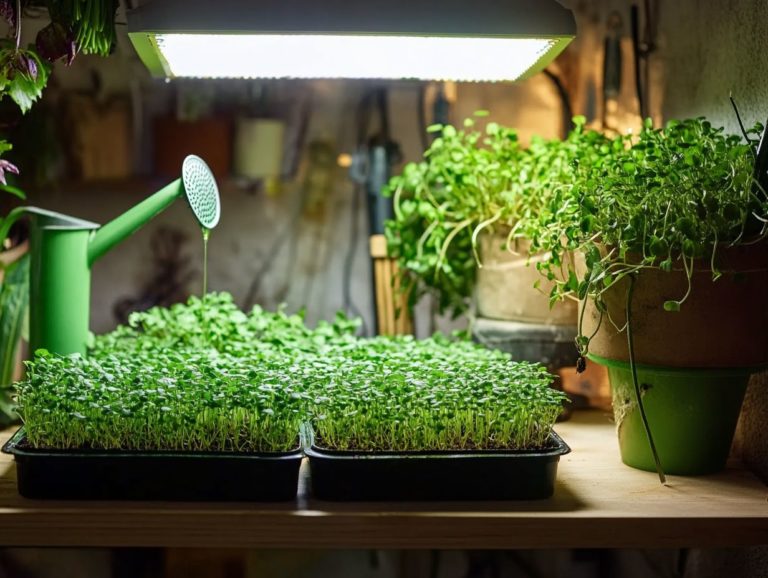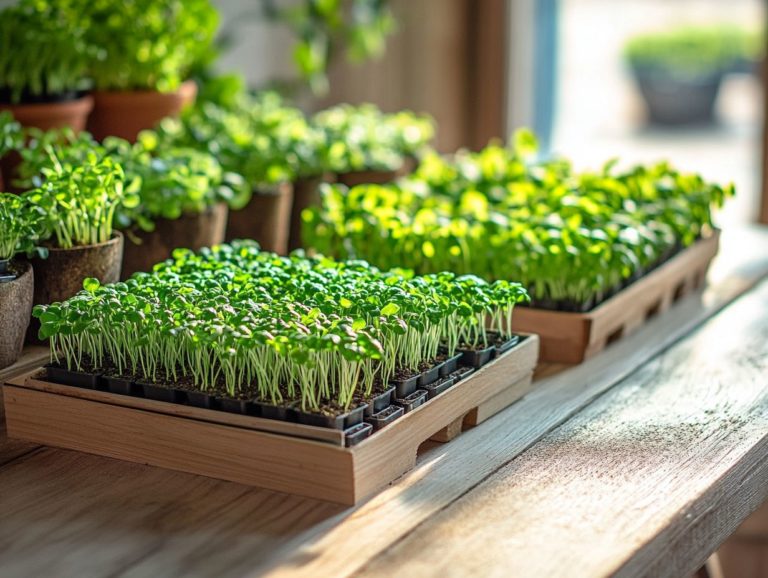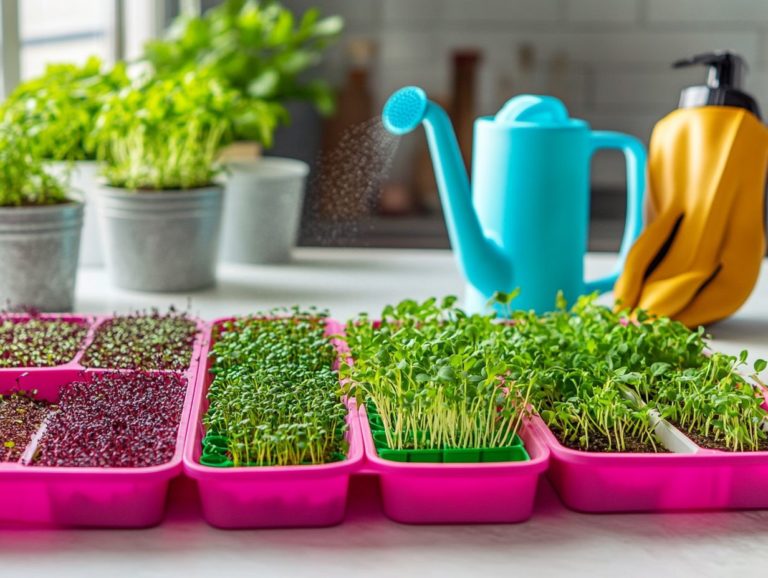5 Best Microgreen Growing Platforms
Microgreens have surged in popularity within the culinary sphere, celebrated for their vibrant flavors and remarkable nutritional advantages. Growing trays are essential for maximizing your microgreen gardening success.
If you’re considering the journey to becoming a home microgreens grower or an aspiring urban farmer, selecting the right growing platform is crucial for your success. Discover the amazing benefits of five top systems for cultivating microgreens, ranging from hydroponics to aeroponics, including the best microgreens to grow for maximum flavor and nutrition.
Uncover the unique benefits, best practices, and common pitfalls associated with each platform, along with gardening tips to enhance your experience.
Unveil the secrets to creating flourishing microgreen gardens with our microgreens podcast for additional insights!
Contents
- Key Takeaways:
- 1. Hydroponic Systems
- 2. Vertical Farming
- 3. Aquaponics
- 4. Soil-Based Systems
- 5. Aeroponics
- What Are Microgreens and Why Should You Grow Them?
- What Are the Benefits of Using a Growing Platform for Microgreens?
- Choosing the Right Growing Platform Can Make All the Difference!
- How Do Different Growing Platforms Affect the Growth of Microgreens?
- What Are the Best Practices for Growing Microgreens on Each Platform?
- What Are the Most Common Mistakes When Growing Microgreens on a Platform?
- Frequently Asked Questions
- What are the top 5 best microgreen growing platforms, including Urban Leaf and Home Microgreens?
- What sets AeroGarden Harvest apart from other microgreen growing platforms?
- Can the Click & Grow Smart Garden 3 be used for growing other types of plants?
- How does the Hamama Microgreens Growing Kit make growing microgreens easier?
- Can the Back to the Roots Water Garden be used for growing microgreens indoors?
- What makes Chef’n Microgreen Grower a top choice for environmentally-conscious growers interested in sustainable gardening?
Key Takeaways:
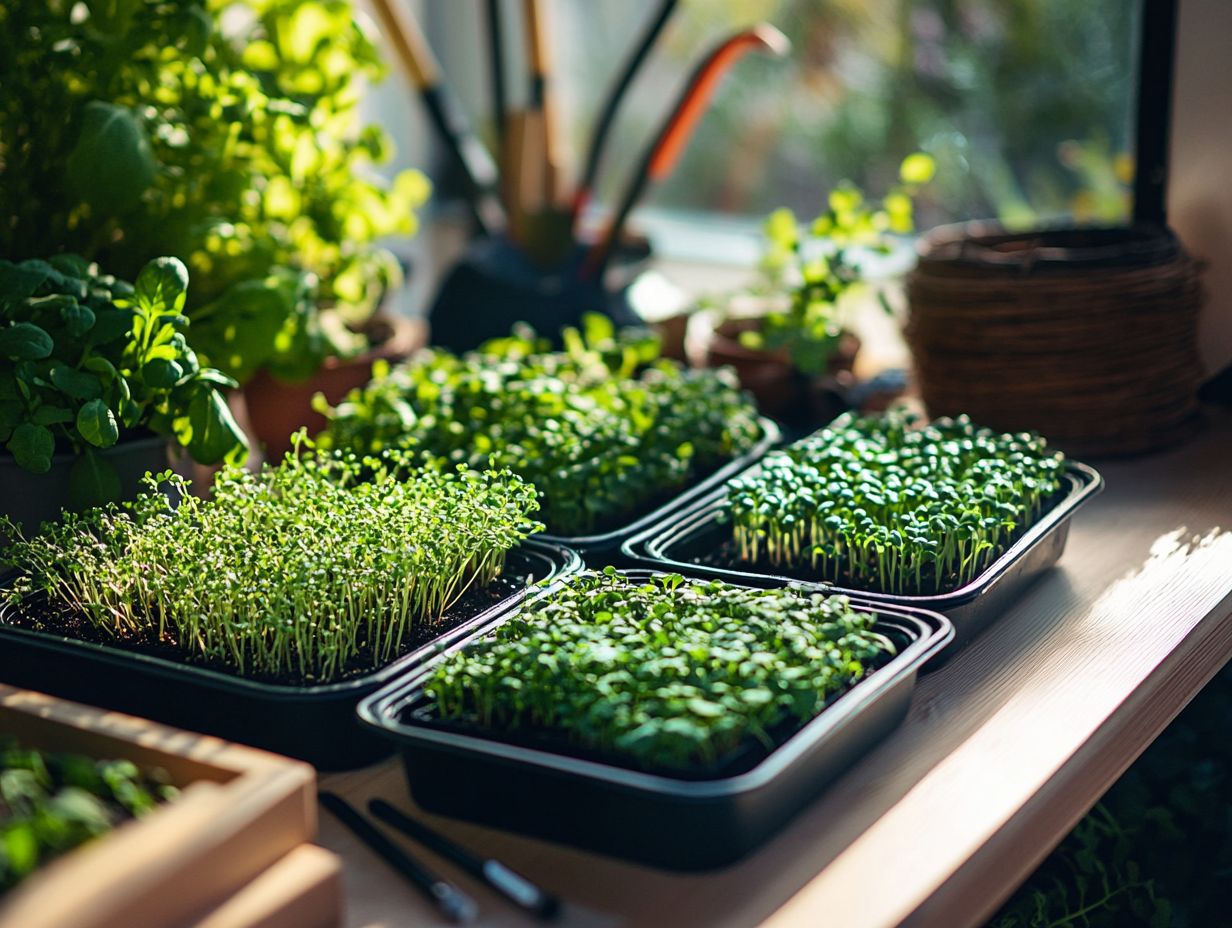
Hydroponic systems provide a water-efficient and customizable option for growing microgreens.
Vertical farming maximizes space and allows for year-round microgreen production.
Aquaponics combines aquaculture and hydroponics for a sustainable and nutrient-rich growing environment for microgreens.
1. Hydroponic Systems
Hydroponic systems offer a revolutionary approach to sustainable gardening, enabling you to cultivate microgreens in meticulously controlled environments. This method optimizes nutrient uptake and water usage while utilizing space-efficient growing trays that can seamlessly fit on any kitchen countertop or in a greenhouse.
This approach promotes faster growth rates and guarantees the production of nutrient-dense greens all year round. It s an ideal choice for urban gardeners and eco-conscious individuals alike.
With a variety of hydroponic systems at your disposal, such as the method where a thin film of nutrient solution flows over the roots (NFT) and the method where roots are submerged in a nutrient-rich water solution (DWC), you can select the method that aligns perfectly with your space and goals. Each approach has unique advantages whether it’s the continuous flow of nutrients provided by NFT or the oxygen-rich environment created by DWC.
Investing in high-quality equipment, like premium trays, microgreen grow lights, and organic nutrients, will significantly enhance the productivity and health of your plants.
By embracing hydroponics, you can relish the satisfaction of enjoying fresh, home-grown produce while actively contributing to the advancement of sustainable agriculture and eco-friendly practices.
2. Vertical Farming
Vertical farming represents an innovative approach that maximizes space efficiency, allowing you to cultivate microgreens and herbs even in small backyards or indoor gardening settings. By leveraging advanced growing techniques and technologies, you enhance productivity and contribute to a sustainable ecosystem, effectively reducing the carbon footprint associated with traditional agriculture practices.
Utilizing hydroponics or aeroponics, this cultivation method enables year-round production, regardless of climate conditions, ensuring you enjoy fresher produce, such as nutrient-dense kale microgreens, with higher nutrient retention. Imagine growing popular microgreens like basil, arugula, and radish greens; these thrive in vertical systems thanks to their rapid growth cycles, and there are even creative ways to grow microgreens that can enhance your gardening experience.
Vertical farming also supports urban sustainability by minimizing land use, conserving water, and significantly reducing transportation emissions. This makes it a prime choice for community gardening efforts. As urban areas become increasingly crowded, this method offers a compelling solution to food security challenges, paving the way for a resilient and eco-friendly urban lifestyle.
3. Aquaponics
Aquaponics seamlessly combines fish farming and hydroponics, creating a symbiotic environment where your microgreens thrive in nutrient-rich water from fish. This method is not only sustainable; it actively promotes biodiversity while delivering crops that are packed with nutrients.
If you’re eager to cultivate your own organic seeds and vegetables efficiently, you ll love how this innovative approach transforms your gardening experience all while adhering to eco-friendly practices.
Setting up your aquaponic system is straightforward. You ll need a fish tank, a grow bed for your plants, and a pump to keep the water circulating. Durable trays will also help ensure optimal growth.
With proper maintenance think monitoring moisture levels and ensuring a balanced nutrient cycle your system will thrive beautifully.
As you dive into the world of aquaponics, consider growing microgreens like basil, arugula, and kale. These varieties not only flourish in this environment but also offer essential vitamins and minerals for a healthy diet. The integration of fish farming and hydroponics ensures a continual nutrient cycle, creating an efficient, self-sustaining garden that benefits both your plants and fish alike.
Ready to start your aquaponic journey? Let s dive in!
4. Soil-Based Systems
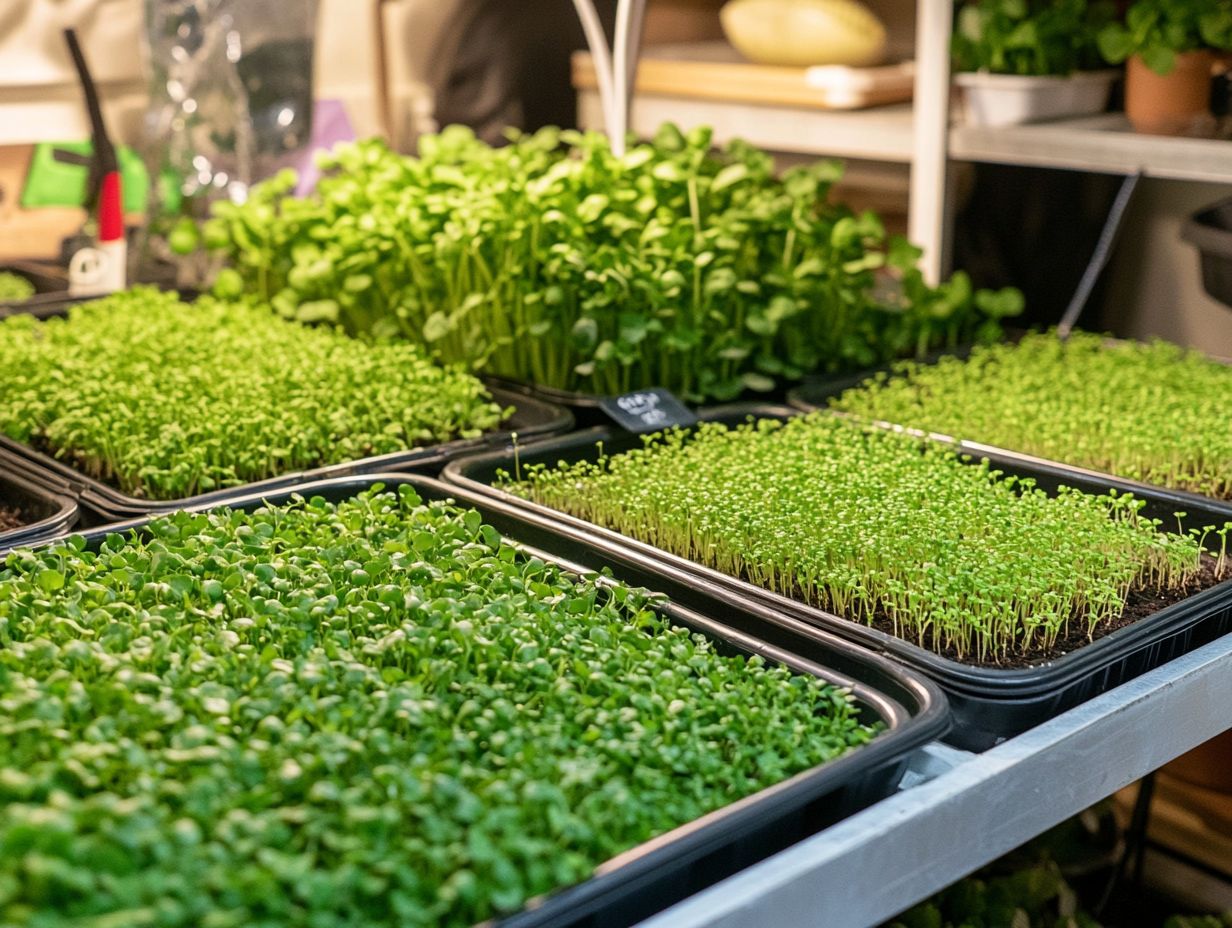
Soil-based systems are a classic yet effective way to grow microgreens, using various soil media like peat moss and coconut coir. By choosing the right soil, you provide essential nutrients that promote robust growth, making it an eco-friendly option for your gardening needs.
You have the opportunity to understand soil requirements and enrich your diet with fresh, vibrant greens.
To optimize your microgreen cultivation, it s crucial to maintain appropriate soil moisture levels. Use watering trays and monitor moisture levels diligently. You can achieve this through consistent watering and moisture-retentive materials.
Integrating organic nutrients into the soil can significantly enhance growth, supplying your microgreens with vital minerals and trace elements.
This connection to soil health fosters a more sustainable garden environment, supporting biodiversity and reducing reliance on chemical fertilizers. Embracing soil-based systems elevates the quality of your microgreens while contributing to a healthier planet.
Excited to get started? Let s cultivate some greens!
5. Aeroponics
Aeroponics is a cutting-edge growing technique that allows you to cultivate microgreens in a space-efficient manner, perfect for indoor gardening enthusiasts. By suspending plants in the air and misting their roots with nutrient-rich water, you enhance moisture levels without the need for soil. This method accelerates growth rates and minimizes water usage.
By embracing aeroponics, you can achieve healthier plants with a higher nutritional content. This setup is perfectly suited for microgreens like:
- Basil
- Radish
- Pea shoots
These microgreens flourish when their roots receive a consistent mist of hydration.
Implementing an aeroponic system at home is easy with a microgreen kit from brands like Bootstrap Farmer, which usually comes complete with everything you need to cultivate these vibrant plants effortlessly. Enjoy the benefits of fresh greens right from your kitchen counter!
Ready to experiment with aeroponics? Let s grow some delicious greens!
What Are Microgreens and Why Should You Grow Them?
Discover microgreens a game changer for your kitchen! These young, edible plants are great for any gardener. They are simple to grow and have a rapid harvest time.
Microgreens add vibrant flavor to your dishes. They also offer an eco-friendly gardening solution when using seeds that haven t been genetically modified.
With a wide variety of seeds to choose from, you can select favorites like basil and radish or try exotic options like beet and amaranth. This variety lets you create diverse flavor profiles that will impress your palate.
Nutritionally, microgreens are a hidden gem. They often contain more vitamins, minerals, and antioxidants than mature plants, making them a great addition to salads, sandwiches, and smoothies.
Growing microgreens at home is easy! It requires minimal space and resources, making it accessible for everyone, especially with microgreen kits. To ensure success, consider these 5 key factors for successful microgreen growing. By embracing this practice, you enrich your diet and contribute to sustainable gardening.
What Are the Benefits of Using a Growing Platform for Microgreens?
Using a growing platform for microgreens offers many benefits, including optimal moisture levels and improved air circulation. This makes gardening more efficient for all experience levels.
Durable trays designed for microgreens are essential for healthy growth. They simplify maintenance and ensure a rewarding gardening experience.
These trays aid in moisture retention, giving your seedlings the hydration they need without the risk of overwatering. This balance boosts seed germination and promotes robust growth.
By using well-draining soil and monitoring humidity levels, you increase your chances of a bountiful harvest. This shows why it s worth investing in the right equipment, like premium bamboo and ceramic trays.
Choosing the Right Growing Platform Can Make All the Difference!
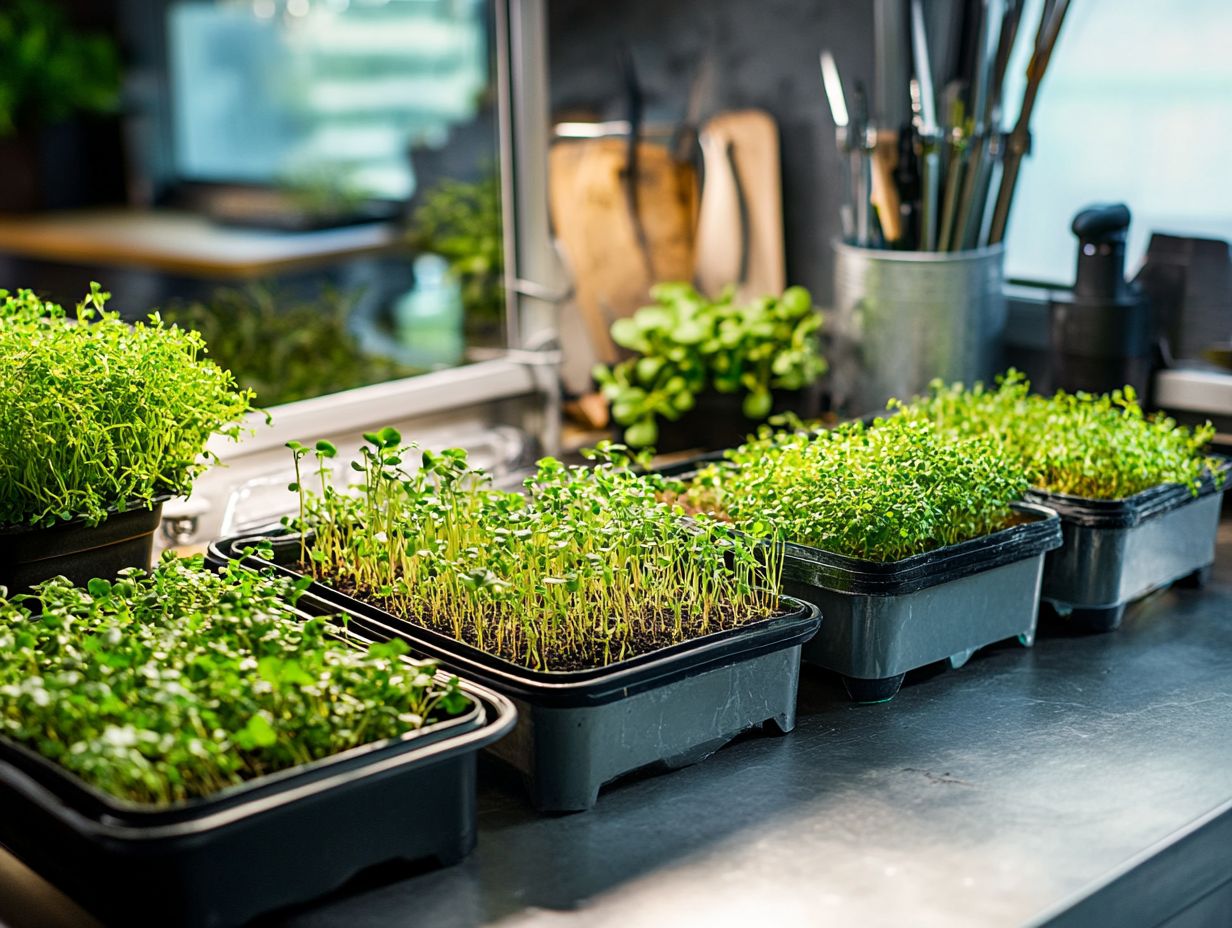
When selecting a growing platform for your microgreens, you should carefully consider key factors such as the available equipment options and the durability of trays. Additionally, think about what kind of soil to use to create optimal growth conditions. The choice of platform can significantly impact the success of your microgreens, leading to healthier plants and more abundant harvests.
Durability is crucial since microgreens thrive on consistent moisture and support. Your growing trays must be capable of withstanding frequent use and cleaning. To avoid common pitfalls, be sure to check out the top 5 mistakes in growing microgreens. You’ll find various sizes of platforms that cater to different spaces, whether you’re working with a compact windowsill or a larger greenhouse setup.
Ensure compatibility with different soil media like coconut coir, peat moss, or soil-less options to meet the specific moisture levels necessary for optimal germination and growth. Don’t overlook essential equipment selections, such as lights and humidity domes. To enhance your success, consider following these tips for successful microgreen germination. These can further boost your growing environment, ensuring your microgreens flourish under diverse conditions.
How Do Different Growing Platforms Affect the Growth of Microgreens?
Different growing platforms can dramatically influence the growth and health of your microgreens. They can affect essential factors like moisture levels, availability of nutrients, and harvesting convenience. Understanding how each platform caters to the specific needs of various microgreens is key to achieving successful cultivation and optimal yields.
For example, platforms with excellent drainage systems can prevent waterlogging, which is detrimental to root health. Your choice of materials will impact temperature regulation and moisture retention, whether you opt for plastic trays or biodegradable alternatives.
Designs that promote proper airflow are vital as they help reduce the risk of mold and enhance the overall vitality of your plants. Evaluate these characteristics to tailor your approach and implement strategies, such as optimizing lighting conditions and fine-tuning your watering schedules, to maximize your yields effectively.
With a solid understanding of these factors, you can cultivate healthier and more robust microgreens with confidence.
What Are the Best Practices for Growing Microgreens on Each Platform?
Implementing best practices for growing microgreens across various platforms can elevate your success and yield. Each planting option should be optimized to meet the unique needs of the microgreens you cultivate. Here are some top tips to ensure your microgreens thrive:
- Monitor moisture levels: Regular checks help maintain the right water balance.
- Select the right growing media: Choose the best soil or soil-less options for your microgreens.
- Utilize premium bamboo trays or durable trays: These provide enhanced support and drainage.
By regularly checking soil moisture and adjusting your watering schedules, you can adeptly prevent both over-saturation and dryness that could hinder germination. Light exposure is equally essential; employing full-spectrum LED lights for 12-16 hours daily can significantly boost growth rates, especially in darker settings.
Tailoring nutrient supplementation to specific microgreen varieties is crucial. Some may require additional organic fertilizers to enhance flavor and nutritional content. For instance, brassicas might thrive on slightly different nutrient profiles compared to leafy greens. This emphasizes the importance of adaptability in your cultivation techniques.
Don’t wait! Start monitoring your moisture levels today to see a difference in your plants!
What Are the Most Common Mistakes When Growing Microgreens on a Platform?
New gardeners often navigate a landscape of common mistakes when growing microgreens on a platform. Issues like improper moisture levels, inadequate soil preparation, and the delicate balance of over or under-watering can hinder growth and yield. By recognizing these pitfalls and understanding the specific soil requirements for various microgreens, you can make your gardening experience enjoyable and successful.
Keeping a close eye on moisture is key to your success! Many beginners underestimate the value of uniform watering, often relying on visual assessments instead of establishing a consistent watering schedule.
Using watering trays improves moisture control, allowing excess water to drain while ensuring the soil stays saturated. This technique prevents waterlogged conditions that can suffocate roots and promotes even germination rates. The result? Healthier, more robust microgreens ready for your table.
Frequently Asked Questions
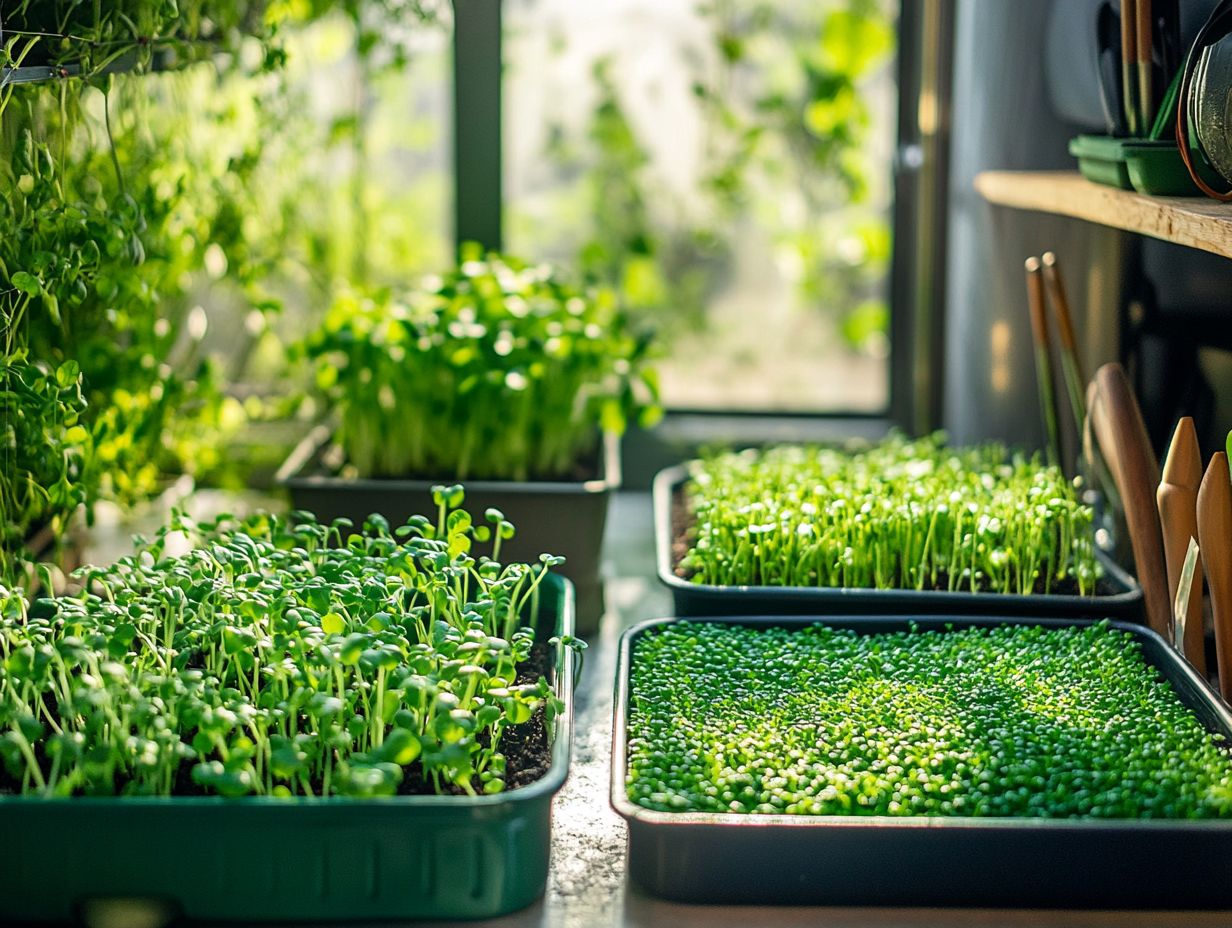
What are the top 5 best microgreen growing platforms, including Urban Leaf and Home Microgreens?
The top 5 best microgreen growing platforms are AeroGarden Harvest, Click & Grow Smart Garden 3, Hamama Microgreens Growing Kit, Back to the Roots Water Garden, and Chef’n Microgreen Grower.
What sets AeroGarden Harvest apart from other microgreen growing platforms?
AeroGarden Harvest stands out for its compact size, easy-to-use control panel, and customizable LED lighting system, making it a top choice for beginners and experienced growers alike.
Can the Click & Grow Smart Garden 3 be used for growing other types of plants?
Yes, the Click & Grow Smart Garden 3 can grow a variety of plants, including herbs, fruits, and vegetables, making it a versatile option for expanding your gardening abilities.
How does the Hamama Microgreens Growing Kit make growing microgreens easier?
The Hamama Microgreens Growing Kit utilizes a unique seed quilt system that eliminates the need for soil, reducing mess and simplifying the growing process. It also comes with pre-measured seed packets and a reusable tray for easy maintenance.
Can the Back to the Roots Water Garden be used for growing microgreens indoors?
Yes, the Back to the Roots Water Garden is designed for indoor use and is a great option for growing microgreens in small spaces, like apartments or offices.
What makes Chef’n Microgreen Grower a top choice for environmentally-conscious growers interested in sustainable gardening?
Chef’n Microgreen Grower is made from sustainable materials and uses a hydroponic system, which grows plants without soil, using water and nutrients instead. This makes it an eco-friendly choice for growing microgreens.
Ready to dive into growing microgreens? Let s explore!
Start growing your own microgreens today for fresh flavors at your fingertips!



